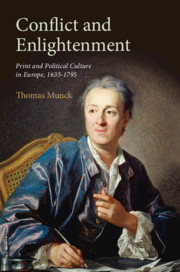Book contents
- Conflict and Enlightenment
- Conflict and Enlightenment
- Copyright page
- Contents
- Figures
- Acknowledgements
- Introduction
- 1 Print, Production, Authors and Readers
- 2 Instability and Politicisation (1630–77)
- 3 Subversive Print in the Early Enlightenment
- 4 Translation and Transmission across Cultural Borders
- 5 High Enlightenment, Political Texts and Reform 1748–89
- 6 Revolution: Democracy and Loyalism in Print 1789–95
- Conclusions
- Select Bibliography (Works Published after 1800)
- Index
3 - Subversive Print in the Early Enlightenment
Published online by Cambridge University Press: 21 October 2019
- Conflict and Enlightenment
- Conflict and Enlightenment
- Copyright page
- Contents
- Figures
- Acknowledgements
- Introduction
- 1 Print, Production, Authors and Readers
- 2 Instability and Politicisation (1630–77)
- 3 Subversive Print in the Early Enlightenment
- 4 Translation and Transmission across Cultural Borders
- 5 High Enlightenment, Political Texts and Reform 1748–89
- 6 Revolution: Democracy and Loyalism in Print 1789–95
- Conclusions
- Select Bibliography (Works Published after 1800)
- Index
Summary
This chapter focuses on the period 1680–1720, noting how religious confrontations exacerbated tensions between different visions of legitimate power and civic society across many parts of Europe. This instability is reflected both in the experimental work produced by some writers and in the need for subversive texts to be disseminated illegally to evade censors. Textual analysis of the Bible itself led to profound controversies to which the only rational response seemed to be the implementation of some form of religious toleration, but no government could do so effectively. This chapter looks at the very different arguments and styles deployed by a range of writers from Hobbes and Spinoza to less well–known underground polemicists in the early years of the eighteenth century. A rich vein of fictional writing, too, confirms that this was a period of huge significance in terms of questioning established authority in all fields of knowledge, creating new networks of writers with ideas that might be considered ‘dangerous’, and laying solid foundations for a recognisable public opinion. Print was creating an effective ‘republic of readers’.
- Type
- Chapter
- Information
- Conflict and EnlightenmentPrint and Political Culture in Europe, 1635–1795, pp. 128 - 179Publisher: Cambridge University PressPrint publication year: 2019

